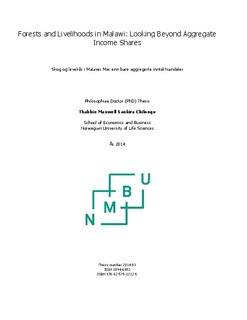| dc.contributor.advisor | Angelsen, Arild | |
| dc.contributor.advisor | Shively, Gerald | |
| dc.contributor.author | Chilongo, Thabbie Maxwell Saukira | |
| dc.date.accessioned | 2016-12-20T10:22:01Z | |
| dc.date.available | 2016-12-20T10:22:01Z | |
| dc.date.issued | 2014 | |
| dc.identifier.isbn | 978-82-575-1212-5 | |
| dc.identifier.issn | 1894-6402 | |
| dc.identifier.uri | http://hdl.handle.net/11250/2425542 | |
| dc.description.abstract | This thesis assesses the role and determinants of forest products on livelihoods of rural households surrounding Chimaliro and Liwonde forest reserves in Malawi. The task is achieved in four independent but thematically-related papers. The thesis consists of an introductory chapter, which summarizes and synthesizes the papers. Full paper insertions follow the introductory chapter.
Paper I investigates rural livelihood strategies in Malawi. Specifically, the study addresses three questions. First, what are the main livelihood strategies? Second, what shapes these strategies? Third, how do the outcomes of these livelihood strategies compare with the degree of household forest reliance? Principal component and cluster analyses identify four livelihood strategies at each site. The findings suggest that some households turn to forest and other non-agricultural activities to compliment inadequate agricultural income.
Paper II assesses the relationship between labor productivity and forest reliance by testing the hypothesis that the forest is an employer of last resort. The paper employs a 2SLS method to estimate shadow wages in a composite agriculture-forest output as a proxy for household labor productivity. Despite that the market wage rate exceeds the average household shadow wage, the low-incidence of off-farm employment in the sample suggests strong rationing in the labor market. This means households continue to depend on self-provisioning activities, implying eventual negative consequences for the local agricultural and forest resource base. The policy implication from this finding is that environmental conservation goals will be advanced by investing in agriculture and expanding employment opportunities in rural areas.
Paper III investigates the role of forest products in filling the seasonal income gaps in a rural developing country context. The study uses quarterly survey data collected over a period of one year. Apart from the commonly used correlation measure, the paper introduces a new seasonal gap filling measure that separates seasonal and interhousehold income variation. The results demonstrate that forest products play a seasonal gap filling role for the low-income households and those households where forest is one of the main livelihood activities.
Paper IV investigates the role forest income plays in movements in and out of poverty. Using a two-period, balanced panel data set of 248 households, the paper tests whether households with high forest reliance are likely to remain poor or fall into poverty and whether forest use is a safety net when households fall into poverty or face shocks. The results suggest that forests were not poverty traps but rather fulfilled important safety net functions for the chronically poor and households that fell into poverty. | nb_NO |
| dc.language.iso | eng | nb_NO |
| dc.publisher | Norwegian University of Life Sciences, Ås | |
| dc.relation.ispartofseries | PhD Thesis;2014:51 | |
| dc.title | Forests and livelihoods in Malawi : looking beyond aggregate income shares | nb_NO |
| dc.title.alternative | Skog og levekår i Malawi : mer enn bare aggregerte inntektsandeler | nb_NO |
| dc.type | Doctoral thesis | nb_NO |
| dc.source.pagenumber | 194 | nb_NO |
